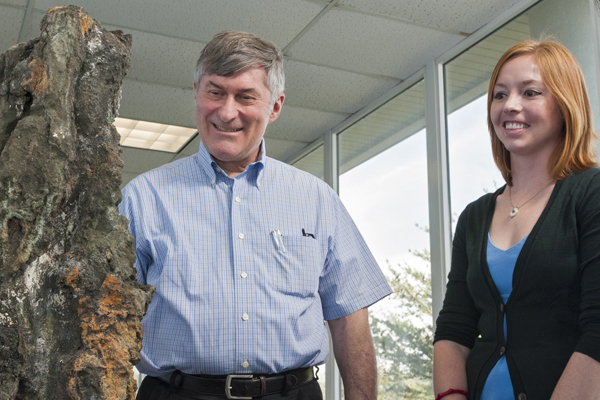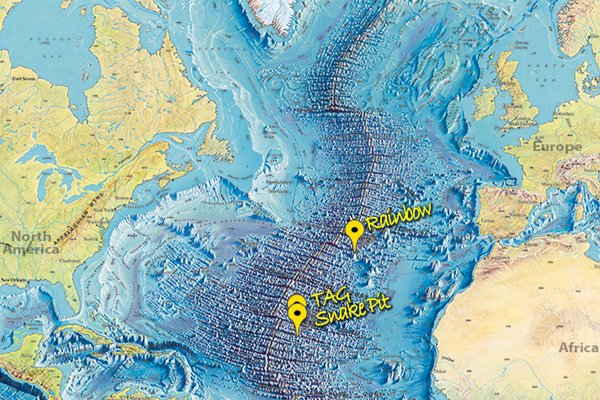


Atlantic quest
Oceanographer leading expedition to hydrothermal vents for pyrite research
9:06 a.m., Oct. 23, 2012--Last year, University of Delaware scientists made a splash with findings that tiny pieces of pyrite, also known as fool’s gold, from hydrothermal vents travel long distances deep within the Pacific Ocean. Now, they want to know if that is also true in the Atlantic.
College of Earth, Ocean, and Environment researchers are currently at sea — smack in the middle of the Atlantic Ocean — to find out. Led by George W. Luther, III, Maxwell P. and Mildred H. Harrington Professor of Oceanography, the team is investigating elements gushing from the vents and the implications for surrounding environments.
Research Stories
Chronic wounds
Prof. Heck's legacy
“Between the Pacific and the Atlantic, we’ll have a really good idea of the different kinds of sulfur and iron concentrations coming out of the vents,” Luther said.
The crew departed on Oct. 16 from São Miguel, Azores, a small island about 900 miles west of Portugal, for the Mid-Atlantic Ridge, an underwater mountain range that winds longitudinally from near Greenland to south of Africa. They plan to sample vents from three sites -- named Rainbow, TAG and Snake Pit -- located far off the coast of Morocco and Western Sahara. An expedition blog features updates from the field as the scientific team, which includes several undergraduates, carries out its research.
Hydrothermal vents are formed by cracks in the seafloor that release superheated water and minerals from within Earth’s crust. The formations support tubeworms, mussels, crabs and other intriguing life forms that would otherwise have difficulty surviving at such great depths.
Aboard the research vessel Knorr, the scientists are sending the Remotely Operated Vehicle Jason/Medea to the bottom of the ocean to collect samples from vent plumes. The vehicle has titanium major samplers that can withstand very hot temperatures and extend down into the vents to suck water out. The scientists then analyze the water from the samplers for elements including iron, manganese and sulfide.
Luther has developed needle-like electrodes, encased in protective polymers, that take instantaneous readings of the different chemicals in cooler waters near the plumes. He utilized the approach on previous excursions in the South Pacific, helping determine the precise composition of the chemistry near animals living there.
On those trips, his team found that nanoscale pieces of pyrite, 1,000 times smaller than the diameter of a human hair, make up to 10 percent of the iron coming out of hydrothermal vents. Pyrite, which consists of iron and sulfur as iron disulfide, may travel up to 4,000 kilometers away through the ocean at that extremely small size. Given the substance’s slow oxidation rate, pyrite-generated iron can get released in remote parts of the deep sea and provide trace nutrients to bacteria, plankton, fish and other sea life.
Luther recently published a paper in the Proceedings of the National Academy of Sciences based on this earlier research. Along with colleagues from Harvard University and other institutions, co-author Luther and graduate student Amy Gartman found that deep-sea hydrothermal vent geochemistry can affect the distribution of bacteria that live in snails. Snails form symbiotic relationships with different types of bacteria depending on the temperature and composition of vent fluids.
On this trip, the researchers will compare even more vents. The Rainbow vent is known to have higher concentrations of iron than sulfides, while Snake Pit and TAG have more sulfides than iron. The scientists hope to determine whether the pyrite nanoparticles are an iron source in the Atlantic as well as the Pacific, suggesting they are ubiquitous for all vents.
“So we can get a real range,” Luther said.
Studying the geology, chemistry and biology of hydrothermal vents highlight the intersection of various disciplines in the field of marine science — something the crew hopes to interest future scientists about. Bill Geppert, a marine science and robotics teacher at Cape Henlopen High School in Lewes, Del., joined the journey to communicate with students while in the field. Classes can follow the project by checking the blog and utilizing educational resources available there.
The cruise is scheduled to end on Nov. 8 in Charleston, S.C.
Article by Teresa Messmore
Photos by Evan Krape and Tammy Beeson









